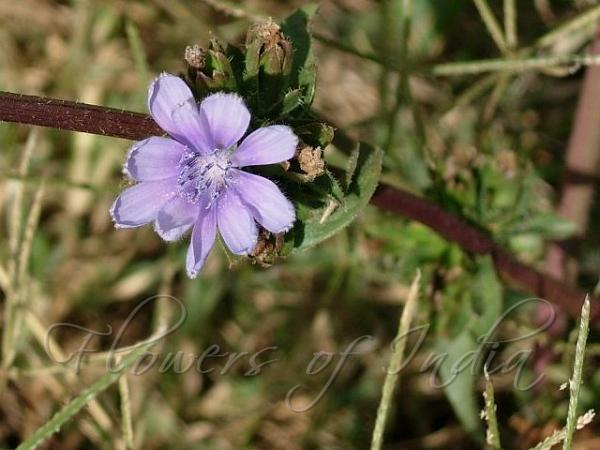|
| Chicory |
|

|

| File size | 65504 |
| Original date | 4/14/08 9:36 AM |
| Resolution | 1024 x 768 |
| Flash | Flash did not fire, auto |
| Focal length | 17.0mm |
| Exposure time | 1/912s |
| Aperture | 4.0 |
| Focus Distance | |
| Metering Mode | Multi-segment |
| Camera make | NIKON |
| Camera model | E5200 |
| Sensor type |
|
|
|
|
Photo: |
Botanical name: Cichorium intybus Family: Asteraceae (Sunflower family)
Chicory is a bushy perennial herb with blue or lavender flowers. It is a
bushy perennial plant that attains a height of 1 to 4 feet. The stem has
edges having hard branches. Flowers occur either solitary on nearly
leafless branches, or in clusters in leaf axils. Flower-heads are 2.5-4 cm
across, with spreading ray-florets. The green bracts below the flowers are
prominent. The outer lancelike bracts are spreading outwards, while the
longer inner ones are upright. Leaves are oblong-lancelike, and lower
leaves are pinnately lobed. The upper leaves are entire, bract-like,
stem-clasping. Root is like a tail of a cow and is fleshy having brownish
color from outside and white color from inside. It has a length of 2 ½
feet and has a bitter taste. Chicory is grown for its leaves, or for the
roots, which are baked, ground, and used as a coffee substitute in instant
coffee. In India Chicory is found in the northwestern regions like Kashmir
and Punjab and in areas of south India.
Medicinal uses: The ancient Egyptians ate large amounts of
chicory because it was believed that the plant could purify the blood and
liver, while others have relied on the herb for its power to cure
"passions of the heart." Chicory continues to be a popular herbal remedy
due to its healing effects on several ailments.
The ancient Egyptians ate large amounts of
chicory because it was believed that the plant could purify the blood and
liver, while others have relied on the herb for its power to cure
"passions of the heart." Chicory continues to be a popular herbal remedy
due to its healing effects on several ailments.
Medicinal uses:
 The ancient Egyptians ate large amounts of
chicory because it was believed that the plant could purify the blood and
liver, while others have relied on the herb for its power to cure
"passions of the heart." Chicory continues to be a popular herbal remedy
due to its healing effects on several ailments.
The ancient Egyptians ate large amounts of
chicory because it was believed that the plant could purify the blood and
liver, while others have relied on the herb for its power to cure
"passions of the heart." Chicory continues to be a popular herbal remedy
due to its healing effects on several ailments. | Identification credit: Lakshmi Subramanian | Photographed in Nasik, Maharashtra. |
• Is this flower misidentified? If yes,